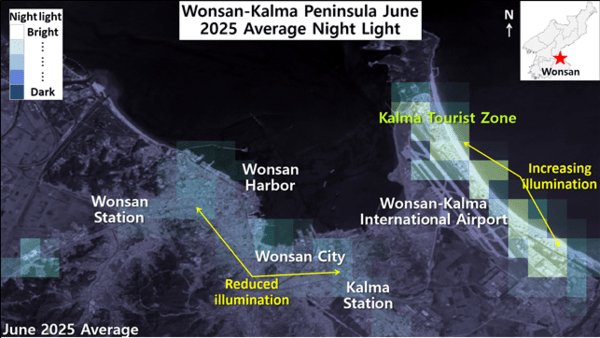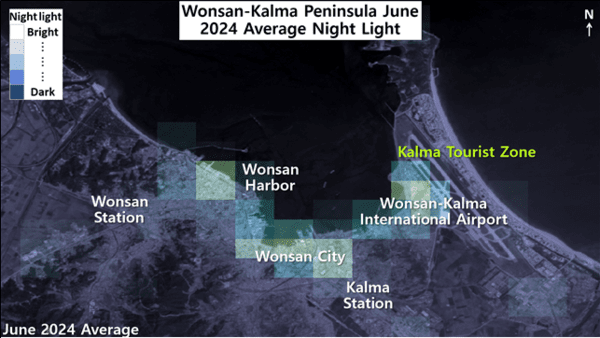
The Kalma Coastal Tourism District in Wonsan, Kangwon Province, which was Kim Jong-un's long-cherished project, opened on July 1 this year, eleven years after construction began. Kim Jong-un attended the splendid completion ceremony with his daughter Joo-ae, and his wife Ri Sol-ju accompanied him. Ri Sol-ju made her first public appearance in a year and a half. As the first foreign guests in the tourist district, a group of Russian tourists visited Kalma Peninsula Beach last July.
The Wonsan-Kalma Tourist Zone, a North Korean version of a complex resort, forms a nightlife that does not extinguish at night, showing off the spectacular night view of the seafront. Satellite images revealed that behind these spectacular late-night light shows at Myongsasimni beach is based on the private sacrifice of electricity restrictions in Wonsan City. The night-time images taken by satellites were analyzed and the status of late-night lighting in the Wonsan-Kalma Peninsula was examined.
◆ Spectacular Night Light at Wonsan-Kalma Peninsula

I looked at Wonsan City and the Kalma Peninsula area using nighttime satellite images made by averaging thirty days' worth of images taken over a month in June. For accurate analysis, it follows a method of reducing errors according to weather conditions. In June, when construction was in full swing ahead of its opening on July 1 this year, night lights were clearly identified along the Myongsasimni beach in the Wonsan-Kalma district. On the other hand, it is believed that night lighting has decreased relatively significantly in Wonsan Port and Wonsan City. It is evaluated that it restricts private electricity in the area of Wonsan City and focuses on the operation of coastal tourism districts and night lighting there.
As satellite data, nighttime images of the Visible Infrared Imaging Radiometer Suite (VIIRS) on the U.S. National Oceanic and Atmospheric Administration’s Joint Polar Satellite System, were used, which photographs the world daily at 1:30 a.m. Nighttime satellite images are widely used for research on night activities in urban areas and economic activities by region by detecting light rising from the earth surface. There are three types of data taken daily and average monthly and average annual. Among them, there are precautions when using daily shooting data. Due to the influence of the weather, night lights are observed cloudy in cloudy weather. In order to reduce weather problems in nighttime satellite images, all data are averaged monthly or annually and used for analysis. It is a method to remove temporary lights such as wildfire flames or squid fishing boat lantern lights and obtain constant night light. The data obtained in this way is called Stable Nighttime Light or SNL in technical terms.
In this study, the actual state of night lighting on the Kalma Peninsula was analyzed using the average image in June. Data can be downloaded and used free of charge on the website of the Earth Observation Group (Index of/nighttime_light/monthly/v10). This study looked at the night illumination changes in the Wonsan-Kalma Peninsula in June last year and this June.
◆ Kalma Peninsula of Darkness at the Time of Construction Suspension

The satellite image above shows the night view of Wonsan City and the Kalma Peninsula at the time when construction of the coastal tourist zone was suspended in June 2024 last year. Night lights shine brightly in Wonsan City, Wonsan Port, and Wonsan-Kalma International Airport. On the other hand, in the Kalma tourist district, lights are not identified and the area is trapped in deep darkness. It is estimated that the area of Wonsan City, the hometown of North Korean leader Kim Jong-un, was supplied with electricity at night centered on the city center at that time.
The coastal tourism development project on the Kalma Peninsula in Wonsan began with Singapore as a model when North Korea designated Wonsan City and Mt. Kumgang in Kangwon Province as special tourist zones in June 2014. As 2020 began, construction was suspended due to financial difficulties and material import disruptions in the aftermath of COVID-19, and construction resumed when Kim Jong-un visited the site again in July 2024, and it opened on July 1 this year after eleven years of construction.
There are two power generation facilities in the area that supply electricity to Wonsan City, Kangwon Province. They are the Wonsan Youth Power Plant completed in 2009, and the Wonsan-Gunmin Power Plant completed in April 2016. The two hydroelectric power plants have produced electricity and supplied it to the Wonsan area, and much of the electricity used by the private sector has now been turned to the Kalma Peninsula, and it is believed that they focus on the operation of coastal tourism district facilities as well as flashy night lights there at night.
This study revealed that the private electricity supplied to the Wonsan City area is limited, and it is understood that a significant amount of it is used to operate recreational facilities in the Kalma Coastal Tourism District. North Korea seems to have started a business to earn foreign currency for foreign tourists in the summer, taking the sacrifice of electricity restrictions by the private sector.
